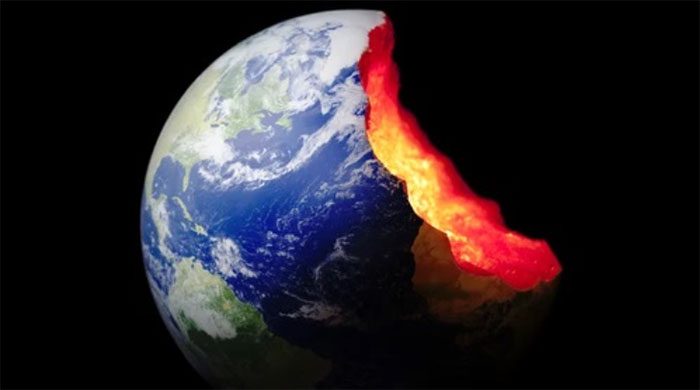The Earth’s core is leaking helium-3, a rare element that could serve as fuel for nuclear fusion and may hold the key to the origin of life.
Scientists believe they may have solved the mystery of how helium-3, a rare element attracting attention as a potential fuel source for nuclear fusion reactors, is leaking out of the Earth’s core, according to a new study.
The study suggests that this ancient material seeps from the core into the outer layers of the Earth, namely the mantle and crust, due to reactions with magnesium oxide.
This discovery could help explore the mysterious inner regions of the Earth, as well as understand how life originated on Earth and whether it could exist elsewhere in the universe.
Helium-3 is an isotope of helium, containing only one neutron in its nucleus instead of two. Most helium-3 was formed shortly after the universe’s inception, making it only “slightly younger” than the universe itself.

Illustrative image: Getty Images
Beyond its initial origins, helium-3 is a hot topic among scientists researching nuclear fusion, exploring a feasible form of clean, limitless energy. The properties of helium-3 make it a potential fuel source for fusion reactions. For this reason, scientists are investigating ways to extract helium-3 that is “trapped” on the Moon.
When the Earth began to form from gas and dust approximately 4.5 billion years ago, primordial helium-3 was trapped within the mixture. As a result, large reservoirs of this isotope have been locked within the Earth’s core, located about 2,900 kilometers beneath our feet. Helium-3 is very rare on the Earth’s surface, but traces of it can be found in volcanic rocks in the oceans, suggesting that an unknown mechanism is allowing the gas to escape from the core.
Currently, two scientists have proposed that a mineral called magnesium oxide (MgO), prevalent in the Earth’s core, may assist helium-3 in leaking from the core to the Earth’s crust and beyond.
In addition to explaining how the rare element helium-3 escapes from the Earth’s core, this research also provides a “pathway to explore processes in the core,” helping to uncover how the Earth became a place where life emerged. This is reported in a new study published in the journal Nature Geoscience.
According to the study’s authors, Jie Deng and Zhixue Du, two geophysicists from Princeton University (USA) and the Guangzhou Institute of Geochemistry (China): “Helium is regarded as a key marker for processes deep within the Earth because the core is believed to contain primordial helium-3 isotopes.”
“However, how helium moves from the core to the Earth’s crust remains unclear,” the research team noted.
They explained: “Here, we use calculations to indicate that helium easily enters magnesium oxide at the boundary between the core and the Earth’s mantle. This suggests that magnesium oxide seeping from the core could transport a significant amount of helium into the mantle.”
Jie Deng and Zhixue Du are not the first scientists to realize that magnesium oxide compounds in the Earth’s core may play a crucial role in many processes affecting life on the Earth’s surface. Previous studies have shown that the movement of MgO from the core upwards has helped create the Earth’s dynamics over billions of years, generating the planet’s magnetic field. This magnetic field protects us from harmful radiation and stabilizes the atmosphere we need to sustain life.
When MgO floats up to the boundary between the outer core (composed of liquid) and the mantle of the Earth, where temperatures are lower than in the core, it will “decompose,” meaning it transforms from a homogeneous mineral into distinct crystalline phases. MgO brings helium-3 with it from the mixed liquid iron core to the boundary between the core and the mantle, where the decomposition process transports both substances into the mantle.
The two scientists, Deng and Du, stated in their research: “Widespread convection in this core region, driven by the release of MgO, could effectively transport helium from the deep regions of the core to the boundary between the core and the mantle.”
“We also modeled the expected helium flow due to magnesium oxide decomposition since the core’s formation, indicating that decomposing magnesium oxide from the core may have continuously provided helium from the core into the mantle throughout much of Earth’s history, imprinting primordial helium into material in the mantle.” – the researchers noted.
While the two scientists mentioned that more research is needed to fully understand these processes, their new study has provided a new piece to the puzzle of the Earth’s core, the furthest region of our world, and identified the mysterious origins of helium-3 on the planet’s surface.
Furthermore, both Deng and Du proposed that the process of mineral decomposition from the core could enrich the mantle and crust with various elements, including components that have led to the emergence of life on Earth.





















































